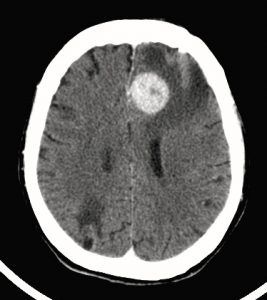There are two types of lymphomas of the brain: primary (originating in the brain) and secondary (coming from another part of the body).
These tumours epidemiologically represent less than 3% of all brain tumours.
Clinical signs

They may cause signs of intracranial hypertension (headache, nausea, vomiting, dizziness, etc.) Depending on their location, they could also cause neurological deficits (lack of strength in an extremity, vision disorders, altered behaviour, speech defects, etc.).
Diagnosis
Correct assessment of the tumour requires performing cerebral magnetic resonance imaging.
These tumours characteristically have a fast response to corticosteroids and practically disappear with this treatment. This means that they used to be referred to as ghost tumours.
Treatment
Experience in neuro-oncology is very important for correct treatment of these lesions for two main reasons:
1 – Not prescribe excessive doses of corticosteroids to leave enough material for definite diagnosis through pathological anatomy.
2 – Not attempt complete resections of the lesions in all cases, as it has not been demonstrated to increase survival and it has been demonstrated to increase the complications, and so complete resection should only be considered when it does not increase the risk of neurological deterioration.
Even though in many cases corticosteroids bring about a rapid reduction in the size of the lesion, they do not cure the disease. The treatment of choice for this pathology is chemotherapy.



